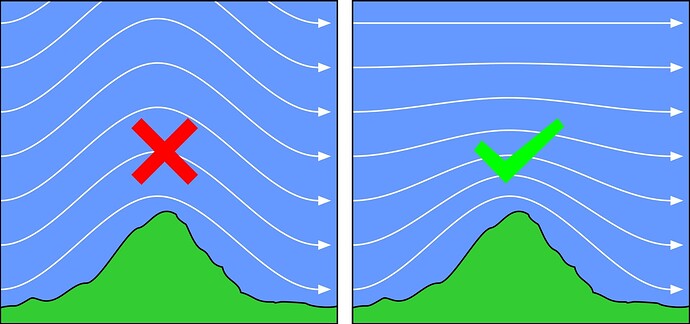ISSUE DESCRIPTION
Description of the issue: When wind encounters an upslope (Orographic lifting), it continues to rise indefinitely
Provide specific location or coordinates:Anywhere
Provide time and date of the observed weather issue: Every time we fly
[PC Only] Did you remove all your community mods/add-ons? If yes, are you still experiencing the issue? yes
FREQUENCY OF ISSUE
How often does this occur for you (Example: Just once, every time on sim load, intermittently)? Every time we fly
REPRODUCTION STEPS
Please list clear steps you took in order to help our test team reproduce the same issue:
- choose a glider
- Create a custom weather preset with the following attributes
a) Stratus layer at circa 2800 Ft AGL shallow depth 3-500 ft
b) Set surface temp low (suggest < 10 degrees celcius
c) Set air pressure low
These conditions are necessary to eliminate - or at least lessen the possibility of anabatic winds affecting the outcome of the test(s) Orographic lifting and Anabatic winds are as defined below
Orographic lifting: Horizontal winds hitting an immoveable object (Mountain or hillside) which is then forced upwards because there is nowhere else for it to go
Anabatic Winds: Air heated by solar radiation hitting the slope of the mountain or hill, which then rises in a similar fashion to thermals
- load in at an airfield in mountainous area with wind speeds in excess of 15Kts
- find a mountain nearby and get on a slope where the wind is hitting it ± 30 degrees from the perpendicular
- Continue flying along the slope, turn around come back. Repeat as necessary
- Stop before you get into space
YOUR SETTINGS
If the issue still occurs with no mods and add-ons, please continue to report your issue. If not, please move this post to the User Support Hub.
What peripherals are you using, if relevant: N/A
[PC Only] Are you using Developer Mode or have you made any changes to it? N/A
[PC, MSFS 2020 Only] Are you using DX11 or DX12?
[PC Only] What GPU (Graphics Card) do you use? AMD 7800XT
[PC Only] What other relevant PC specs can you share? N/A
MEDIA
Please add a screenshot or video of the issue occurring.
So I asked ChatGPT about Orograhic Lifting - but there are innumerable sources on the internet including but not limited to the American Meteorological Society
https://glossary.ametsoc.org/wiki/Orographic_lifting
"Great Question. In meteorology, when wind hits a slope (like a mountain), it’s forced to rise — this is called orographic lift. However, it doesn’t ascend forever. Here’s why:
###1. Not relevant since it relates to Anabatic winds
2. Loss of Momentum
The wind provides the horizontal momentum that drives air upslope. But that force weakens once:
- The terrain ends (the air crests the mountain).
- Friction and drag slow it down.
- Gravity pulls the air back down if it’s denser than the surrounding air.
Summary
Air stops rising due to:
- Atmospheric stability
*** Loss of momentum** - Moisture limitations
- The capping effect of the tropopause
These all combine to prevent air from rising indefinitely."
In the case of Orographic lifting, when the air that has been forced upwards reaches the crest of the ridge, the immovable object (mountain or hill) is no longer present. This air is then hit by horizontal winds above the crest which are NOT being forced upwards. Thus the air from below is blown by the horizontal winds until it is itself once again flowing horizontally. There is a period of time (and distance where some upward momentum is still present and effective, but this is short lived as the effects of gravity, friction and the horizontal winds above the crest eventually win.
As a VERY rough guide from real world experience, the “Top Out” heights would be around 500ft for every 5 Knots of wind but ignoring the first 5Kts which would be sufficient to maintain level flight only (depends on weight of the aircraft)
For the avoidance of doubt 10Kts wind = 500ft, 15Kts = 1000ft 20Kts = 1500ft etc
So - over to you guys. We look forward to realistic ridge lift at some point in the foreseeable future.
[END OF FIRST USER REPORT]
![]() For anyone who wants to contribute on this issue, Click on the button below to use this template:
For anyone who wants to contribute on this issue, Click on the button below to use this template:
Do you have the same issue if you follow the OP’s steps to reproduce it?
•
Provide extra information to complete the original description of the issue:
•
If relevant, provide additional screenshots/video:
•
